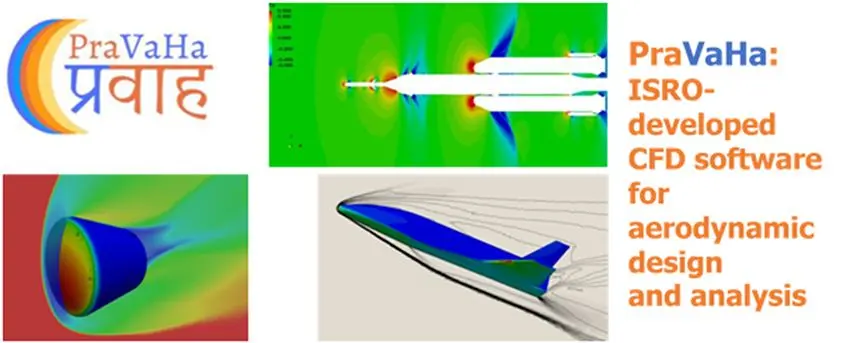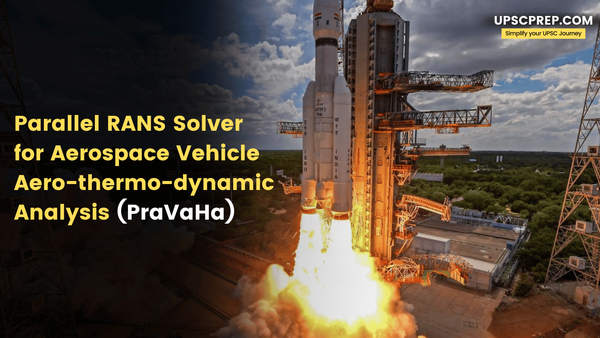Table of contents
The Indian Space Research Organisation (ISRO) has developed a sophisticated Computational Fluid Dynamics (CFD) software named Parallel RANS Solver for Aerospace Vehicle Aero-thermo-dynamic Analysis (PraVaHa).

This software, developed at ISRO’s Vikram Sarabhai Space Centre (VSSC), is a significant advancement in the field of aerospace engineering and has several critical applications.
Key Features of PraVaHa
- Simulation Capabilities:
- External and Internal Flows: PraVaHa can simulate both external and internal flows on various aerospace vehicles, including launch vehicles and re-entry vehicles (both winged and non-winged).
- Aerodynamic and Aerothermal Loads: It predicts aerodynamic and aerothermal loads, which are crucial for designing the shape, structure, and Thermal Protection System (TPS) of aerospace vehicles.
Applications
- Launch Vehicles: Used for aerodynamic analysis of human-rated launch vehicles such as HLVM3.
- Re-entry Vehicles: Essential for understanding airflow around Crew Modules (CM) during earth re-entry.
- Crew Escape System (CES): Analysis of aerodynamic behavior during emergency escape scenarios.
Technical Specifications
- Perfect Gas & Real Gas Conditions: Currently operational to simulate airflow under these conditions.
- Chemical Reactions: Validations are underway to simulate chemical reactions that occur during air dissociation upon earth re-entry and combustion in scramjet vehicles.

Significance of PraVaHa
- Enhanced Design Capabilities:
- Aerodynamic Design Studies: Facilitates the evaluation of a large number of configurations during the initial aerodynamic design studies for launch vehicles.
- Thermal Protection: Helps in designing effective TPS by predicting heat flux and external pressure accurately.
- Improved Safety and Reliability:
- Human-rated Missions: Extensively used in the Gaganyaan program, enhancing the safety and reliability of human spaceflight missions.
- Acoustic Noise Reduction: Addresses unsteady aerodynamic issues that contribute to significant acoustic noise during missions.
- Cost and Time Efficiency:
- Numerical Simulations: Reduces the need for extensive physical testing by providing accurate numerical simulations, thereby saving time and costs in the design and testing phases.
- Technological Advancement:
- Indigenous Development: This represents a significant technological advancement by ISRO, showcasing India's growing capabilities in aerospace technology.
- Global Competitiveness: Enhances India's position in the global aerospace sector by developing cutting-edge simulation tools.
Broader Implications
- Space Exploration:
- Mission Planning: Facilitates better planning and execution of complex space missions by providing detailed aerodynamic and aerothermal analysis.
- Re-entry Missions: Critical for the success of re-entry missions, ensuring the safe return of spacecraft and crew modules.
- Defence Applications:
- Missile Technology: Can be applied to improve the design and performance of missile systems, enhancing national defence capabilities.
- Academic and Research Contributions:
- Research Tool: This tool provides a valuable tool for academic and research institutions to study fluid dynamics and aerodynamics in aerospace applications.
- Collaboration: Opens up opportunities for collaboration with international space agencies and research organizations.
Conclusion
The development of PraVaHa by ISRO marks a significant milestone in India's aerospace capabilities.
- It enhances the design and safety of aerospace vehicles and positions India as a leader in aerospace technology.
- This advancement is crucial for the success of future space missions, including human spaceflight programs like Gaganyaan, and has broader implications for defence and research sectors.
Understanding the technical and strategic significance of such developments is essential for UPSC aspirants, particularly in the context of Science and Technology in the GS-III syllabus.
Previous Post